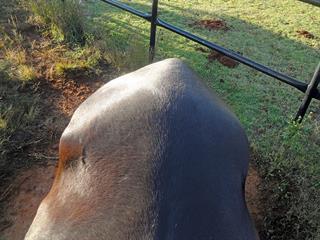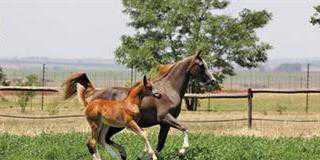
Most horse owners would associate the word ‘lameness’ with legs and hooves. Unfortunately, lameness can also come from higher up the skeleton – namely, the pelvic area. This form of lameness is not very common, but it’s important to know what to look for. The good news is that due to improved diagnostic tools, the prognosis for pelvic problems is much better than before.
As pelvic injuries often result from trauma, they can affect horses of any breed, gender, age or discipline. However, they are more common among young untrained horses, which are susceptible to falls during training. Also at higher risk are performance horses at the upper levels of their sport, particularly those in high-stress disciplines such as jumping, dressage, reining, and Western. These animals experience more wear and tear, making them susceptible to ligament injuries and degenerative joint disease throughout their bodies, including the pelvic region.
Ultrasound
Traditionally, when a lameness examination (including limb flexion tests, sacroiliac joint blocks, and rectal palpations to assess sacroiliac motion) has indicated the possibility of pelvic trouble, a large X-ray machine was the only tool available to image the area. This process has two disadvantages: it is expensive and it requires a general anaesthetic.
Ultrasound, by contrast, is relatively affordable and uses a rectal probe without anaesthetic. It is useful for identifying bone fractures and arthritis and assessing abnormal ligament size to diagnose pelvic-area ligament injuries.Treatment for pelvic lameness and fractures varies from case to case. It should include stable rest of between three to eight months as well as conditioning, particularly in cases of sacroiliac ligament and muscle damage.
Recovery Programme
The horse is put through the same kind of programme as used for a bowed tendon – rest and then controlled exercise. The programme teaches the horse to utilise the lumbar (lower back) muscles in a more appropriate manner to stabilise and support the pelvic region.
Collection (when a horse carries more weight on its hindquarters than its forelegs) is painful if it is suffering from pelvic disorders, so the programme encourages the horse to move in a long, low frame that allows it to stretch while engaging its back. This starts with walking, then moves to walking over poles, while still allowing the horse to put its head down. Next is hill work, which builds up to trotting, still with the long and low profile. Eventually, the horse is taken through an hour of exercise, with 30 to 35 minutes of trotting, and five minutes of canter.
Recovery from pelvic injuries depends on the severity of the problem, how long it went untreated, and how dedicated the owner is to a complete rehabilitation programme. A horse with advanced degeneration of the sacral joint has a poorer prognosis than one in the early stages of the disease.
An animal that has suffered significant muscle atrophy due to prolonged use while injured or due to repeated, untreated injury of the sacroiliac ligaments will need more recovery time than one which strained a ligament a week before and has already started a rest and rehabilitation programme.












